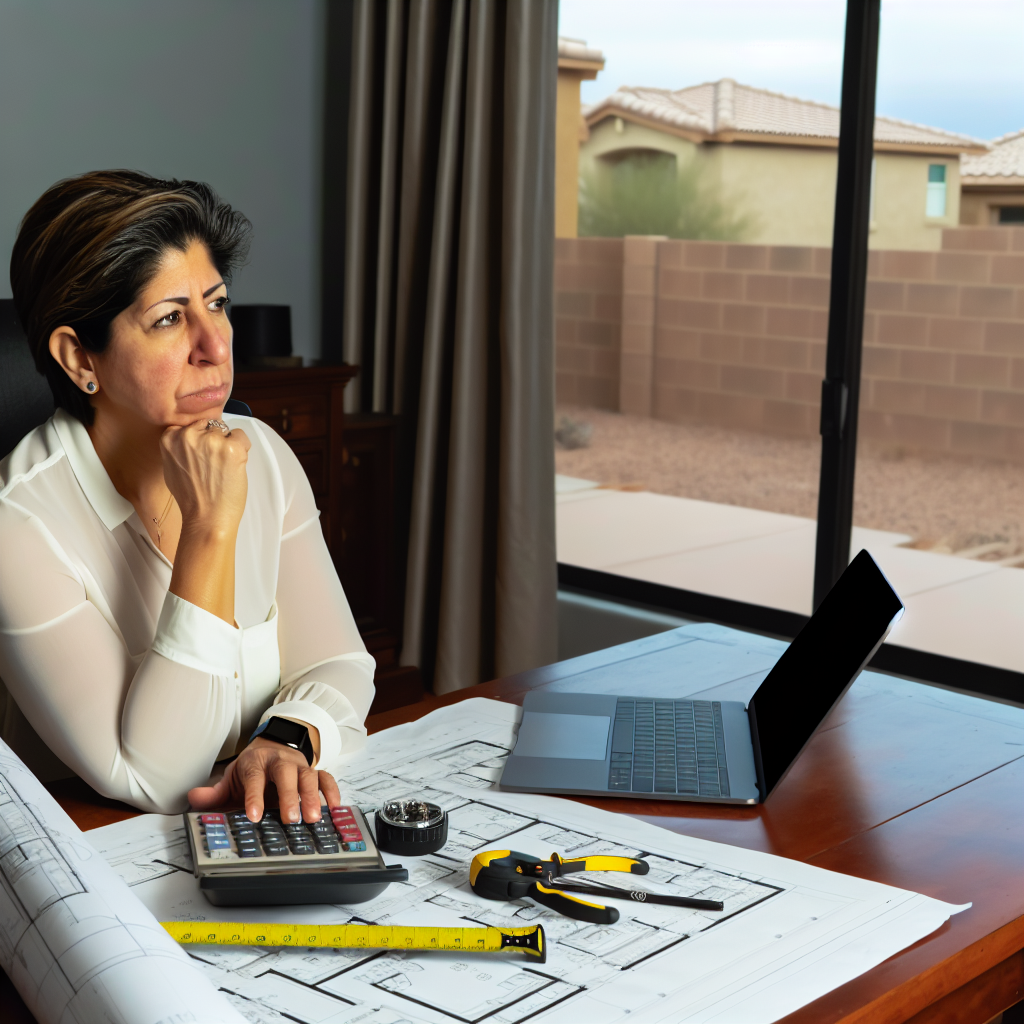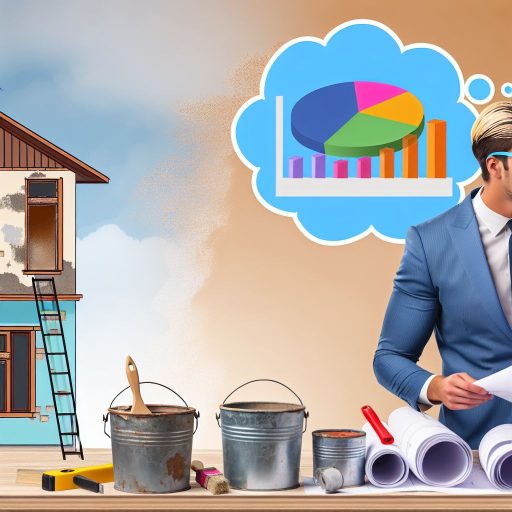Introduction to House Flipping and Profit Calculation
House flipping is a popular investment strategy.
It involves purchasing properties, renovating them, and selling for a profit.
This approach can yield significant returns if executed correctly.
However, it requires careful planning and financial analysis.
Understanding potential profits is crucial for success in this endeavor.
Key Factors to Consider in Profit Calculation
Calculating potential profits involves several key factors.
First, you must determine the purchase price of the property.
Next, consider renovation costs.
These can include materials, labor, and unexpected expenses.
Additionally, property taxes and insurance should be included.
Finally, factor in the selling price.
Market trends can significantly affect this figure.
Estimating Rehabilitation Costs
Accurate estimates for rehabilitation costs are essential for profitability.
Start by conducting a thorough inspection of the property.
Identify items that need repairs or upgrades.
Consider hiring a contractor for a detailed quote.
This helps avoid overestimating or underestimating costs.
Understanding the Real Estate Market
The real estate market plays a vital role in house flipping success.
Research current trends and property values in the area.
Evaluate comparable properties to gauge potential selling prices.
Timing the market can also influence overall profits.
Consider whether to sell in a seller’s or buyer’s market.
Calculating Overall Profit Potential
Once you have gathered the necessary data, calculating overall profit is straightforward.
Begin with the expected selling price.
Subtract the total costs, including purchase, renovation, and carrying costs.
The remaining amount is your potential profit.
It’s essential to maintain a cushion for unexpected expenses.
Importance of a Clear Exit Strategy
Having a clear exit strategy is crucial for fixed income.
Before starting, decide if you’ll flip quickly or hold for rental income.
This decision influences your overall financial strategy.
Additionally, it guides your investment choices throughout the process.
Understanding the Basics of Real Estate Investment
Introduction to Real Estate Investment
Real estate investment involves purchasing properties to generate income.
This income can come from rental payments or profits from sales.
Many investors buy properties, improve them, and then sell for profit.
Types of Real Estate Investments
There are several types of real estate investments to consider.
Residential properties are the most common form of investment.
Commercial properties include office buildings, retail spaces, and warehouse facilities.
Industrial properties are often used for manufacturing and storage.
Each type has its own risk and return profile.
Understanding House Flipping
House flipping is a specific type of real estate investment.
This involves buying a property, renovating it, and selling it quickly.
Flippers aim to make a profit in a short time frame.
Success in house flipping requires market knowledge and renovation skills.
Financial Considerations
Financial analysis is crucial for any real estate investment.
Potential profits depend on the purchase price, renovation costs, and sale price.
Investors should consider carrying costs, such as mortgage payments and taxes.
Analyzing Market Trends
Understanding market trends helps in making informed decisions.
Investors should research local real estate markets before buying.
They can track price trends, neighborhood developments, and demand levels.
Building a Team
A strong team is essential for successful real estate investment.
This team typically includes real estate agents, contractors, and inspectors.
Each member contributes valuable expertise throughout the process.
Risk Management
Investing in real estate comes with inherent risks.
Flippers must be prepared for unexpected expenses and market fluctuations.
Having a solid risk management strategy is wise for minimizing potential losses.
Strengthening Your Real Estate Strategy
Comprehending the basics of real estate investment sets a strong foundation.
Investors who understand the market and necessary calculations will likely succeed.
With diligence and a clear strategy, real estate can be a profitable venture.
Key Metrics for Analyzing Potential Profits
Purchase Price
The purchase price is your initial investment in the property.
Evaluate the market to ensure a fair cost.
Avoid overpaying by conducting thorough research.
Renovation Costs
Track all expenses associated with renovations.
This includes materials, labor, and permits.
Create a detailed budget before beginning work.
After Repair Value (ARV)
The ARV estimates the property’s future market value.
Analyze comparable sales in the area to determine this value.
Accurate ARV is crucial for projecting potential profits.
Holding Costs
Holding costs accumulate during the renovation period.
Include mortgage, property taxes, and insurance in this total.
Factor in these costs to avoid unexpected losses.
Profit Calculation
Subtract total expenses from the ARV to find potential profit.
Include purchase price, renovation costs, and holding costs.
This formula helps in assessing the project’s viability.
Return on Investment (ROI)
ROI measures the efficiency of your investment.
Calculate ROI by dividing profit by total investment.
This metric provides insights into project performance.
Market Trends
Stay informed about local real estate trends.
Market fluctuations can impact your potential profits.
Use this knowledge to make informed decisions.
Uncover the Details: Key Factors To Evaluate Before Purchasing A Fixer-Upper Property
Initial Costs
Purchase Price
The purchase price plays a significant role in your overall budget.
Always research the property’s market value before making an offer.
Compare recent sales of similar properties in the area.
Consider obtaining a professional appraisal to validate your assessment.
Additionally, try to negotiate the lowest possible price to maximize profit.
Closing Costs
Closing costs are necessary expenses when finalizing a property purchase.
These costs typically include fees for inspections and title searches.
Expect to pay for attorney fees, escrow fees, and recording fees as well.
On average, closing costs range from 2% to 5% of the purchase price.
Plan ahead by budgeting for these expenses to avoid surprises.
Total Initial Costs Calculation
To determine your total initial costs, add the purchase price and closing costs together.
For example, if you buy a home for $300,000 and face $10,000 in closing costs, your total is $310,000.
This total serves as the foundation for calculating your potential profits.
Keeping a close eye on these initial costs will help you stay within budget.
See Related Content: How To Estimate And Manage Maintenance Costs For Rental Properties
Renovation Budget: Estimating Repair and Upgrade Expenses
Understanding the Renovation Budget
A renovation budget is crucial for any house flipping project.
It allows you to estimate potential expenses accurately.
Begin with a detailed assessment of the property.
This assessment helps identify necessary repairs and upgrades.
Creating a Detailed List of Expenses
Start by listing all anticipated repairs.
Consider structural, cosmetic, and functional improvements.
For instance, roofing, plumbing, and electrical work are essential.
Include flooring, painting, and kitchen upgrades as well.
Estimating Repair Costs
Research local contractor rates for various services.
This helps you form realistic cost estimates.
Additionally, gather quotes from multiple contractors.
Compare these estimates to find the best value.
Accounting for Unexpected Expenses
Always include a buffer for unexpected costs.
A general guideline is to add 10-20% of the total budget.
This reduces the risk of going over budget during renovations.
Tracking Progress and Costs
Maintain a spreadsheet to track expenses throughout the project.
Regularly compare planned versus actual expenditures.
This will help you stay within budget and adjust as necessary.
Find Out More: Analyzing Market Demand To Make Informed House Flipping Decisions
Selling Costs
Realtor Fees
Realtor fees can significantly impact your profits from a house flipping project.
Typically, these fees range from 5% to 6% of the selling price.
It’s essential to factor this into your profit calculations.
For example, if you sell your house for $300,000, expect to pay around $15,000 to $18,000 in fees.
Choosing the right realtor can help minimize these costs.
Moreover, negotiate the percentage when engaging their services.
Marketing Costs
Marketing your property effectively can attract potential buyers.
This often requires an additional budget.
Common marketing costs can include online listings, flyers, and photography.
High-quality images can significantly improve your property’s appeal.
Set aside around $2,000 to $5,000 for these services.
Remember, effective marketing can lead to a quicker sale.
Staging Costs
Staging your home can enhance its visual appeal.
This process can help buyers envision themselves living in the space.
Professionally staging a home typically costs between $1,500 and $3,000.
Consider the potential return on investment this cost offers.
Staged homes often sell for higher prices than unstaged ones.
Thus, the upfront staging cost can be worth it in the end.
Additional Selling Costs
In addition to the main costs, be aware of miscellaneous selling costs.
These may include closing costs, repairs, and utilities.
Closing costs generally run about 2% to 5% of the home’s selling price.
Plan for unexpected repairs that may arise during the selling period.
Overall, budgeting for these additional costs will help finalize your estimates.
Uncover the Details: Best Strategies For Marketing Your Rental Property To Potential Tenants

Calculating After Repair Value (ARV)
Understanding ARV
After Repair Value (ARV) is crucial for house flipping projects.
This value estimates the property’s worth after renovations.
Accurately calculating ARV helps project potential profits.
Factors Influencing ARV
Several factors determine the ARV of a property.
- Location is one of the most significant influences.
- Property size and layout also play critical roles.
- The quality and extent of renovations impact the final value.
- Market trends affect buyer demand and prices.
Researching Comparable Properties
To calculate ARV, start by researching comparable properties.
These properties should be similar in size, location, and features.
Analyze recent sales data to gauge market value.
Look for properties that have been successfully flipped.
Calculating ARV Step-by-Step
Begin by finding at least three comparable properties.
Gather information on their sale prices after renovations.
Calculate the average sale price of these properties.
This average will help establish your ARV.
Accounting for Renovation Costs
Factor in your estimated renovation costs for accuracy.
Subtract these costs from the ARV to calculate potential profits.
Ensure your budget is detailed and realistic.
Always include unexpected expenses in your calculations.
Final Considerations
Keep in mind that the housing market can fluctuate.
Your ARV calculation should remain flexible to these changes.
Regularly review market conditions before finalizing your estimates.
Formulating a Profit Projection
Understanding Income Potential
A critical part of house flipping is estimating potential income.
Start by analyzing the local real estate market.
Assess average home prices in the neighborhood.
This data helps set realistic selling prices.
Additionally, consider possible appreciation over time.
Account for any unique features that add value.
Then, evaluate the property’s after-repair value (ARV).
ARV is essential for determining profit margins.
Calculating Expenses
Next, outline all anticipated expenses.
Costs include acquisition, renovation, and closing fees.
First, calculate the purchase price of the property.
Next, include financing costs, such as interest rates.
Don’t forget to budget for repair and renovation costs.
These can significantly vary depending on the property’s condition.
Consider hiring professional inspectors for accurate assessments.
Additional Costs
Include any additional costs that may arise.
For instance, property taxes and insurance are vital expenses.
Moreover, factor in utility costs during renovations.
Lastly, plan for unexpected costs, often known as contingencies.
Evaluating Profit Margins
After establishing income and expenses, calculate potential profits.
Subtract total expenses from total income to find the profit.
For example, if the ARV is $300,000 and total expenses are $250,000,
then the potential profit is $50,000.
However, consider how long the project will take.
Time affects carrying costs and overall profitability.
Using Profit Percentage
Calculate profit percentage for a clearer perspective.
Divide the profit by total expenses, then multiply by 100.
For instance, a $50,000 profit from $250,000 expenses yields 20%.
This metric provides insight into your investment’s efficiency.
Making Informed Decisions
Utilize these calculations to inform your decisions.
Evaluate which properties show the highest profit potential.
Also, consider the estimated time for renovations.
Ultimately, a well-formulated profit projection leads to success.
Evaluating Market Trends: Timing Your Sale for Maximum Gain
Understanding Market Cycles
Markets fluctuate in cycles based on various factors.
Economic conditions, trends, and consumer demands interact to create these cycles.
Recognizing these cycles is essential for successful house flipping.
Identifying Seasonal Trends
Real estate markets often experience seasonal trends.
Spring and summer typically see more listings and buyers.
As a result, you might achieve a higher sale price during these times.
Analyzing Economic Indicators
Economic indicators can guide your timing decisions.
Look for improvements in employment rates and wage growth.
These factors often correlate with increased buyer activity.
Researching Local Real Estate Trends
Your local market requires special attention.
Investigate recent sales and current listings in your area.
Look for neighborhoods experiencing growth or revitalization.
Utilizing Real Estate Reports
Real estate reports provide valuable insights into market performance.
These reports often detail average sale prices and time on the market.
Use these metrics to assess the best timing for your sale.
Engaging with Local Real Estate Professionals
Consulting with a local real estate agent offers additional guidance.
Experienced agents understand the specifics of your local market.
They can advise on ideal timing and marketing strategies.
Assessing Competition
Know your competition to enhance your positioning.
Analyze other properties in your area and their selling prices.
Competitively pricing your home can attract more buyers.
Evaluating Buyer Sentiment
Buyer sentiment can shift based on various factors.
Monitor social media trends and local news for insights.
Stay informed about how buyers perceive the market.
Timing Your Renovations
Renovations may impact your sale timing.
Consider completing updates before peak selling seasons.
Maximizing your property’s appeal can lead to higher offers.
Case Studies: Successful and Unsuccessful House Flipping Scenarios
Successful House Flipping Example
Consider the case of Lily Morgan, an aspiring house flipper.
She purchased a distressed property in a developing neighborhood.
The initial investment included $150,000 for the purchase price.
Lily allocated an additional $50,000 for renovations and repairs.
The home’s value increased significantly after renovations.
Ultimately, Lily sold the property for $300,000.
This gave her a potential profit of $100,000.
Her success stemmed from careful market research and strategic renovations.
Key Strategies of Successful Flippers
- Conduct thorough market analysis before purchasing.
- Identify properties in up-and-coming neighborhoods.
- Focus on cost-effective renovations that increase value.
- Work with reliable contractors to ensure quality work.
Unsuccessful House Flipping Example
Now, let’s examine a less fortunate case involving Mark Taylor.
Mark purchased a historic home, believing it was a valuable investment.
He bought the property for $250,000, planning heavy renovations.
However, unforeseen structural issues arose during the renovations.
These issues caused costs to escalate beyond his budget.
Mark spent over $100,000, significantly exceeding his initial plan.
Ultimately, he sold the home for only $300,000.
This left him with a modest profit of just $50,000.
His primary mistake was failing to assess potential renovation challenges.
Lessons from Unsuccessful Flipping Attempts
- Always conduct a comprehensive property inspection.
- Avoid emotional decisions driven by the property’s charm.
- Budget for unexpected expenses and challenges.
- Consult experts to evaluate renovation needs accurately.
Comparative Analysis of Outcomes
Both Lily and Mark faced distinct circumstances in their house flipping journeys.
Lily’s careful planning resulted in a significant profit.
On the other hand, Mark’s oversight led to reduced returns.
This demonstrates the critical importance of informed decision-making.
Success in house flipping often hinges on thorough preparation.
Therefore, aspiring flippers should learn from these case studies.




